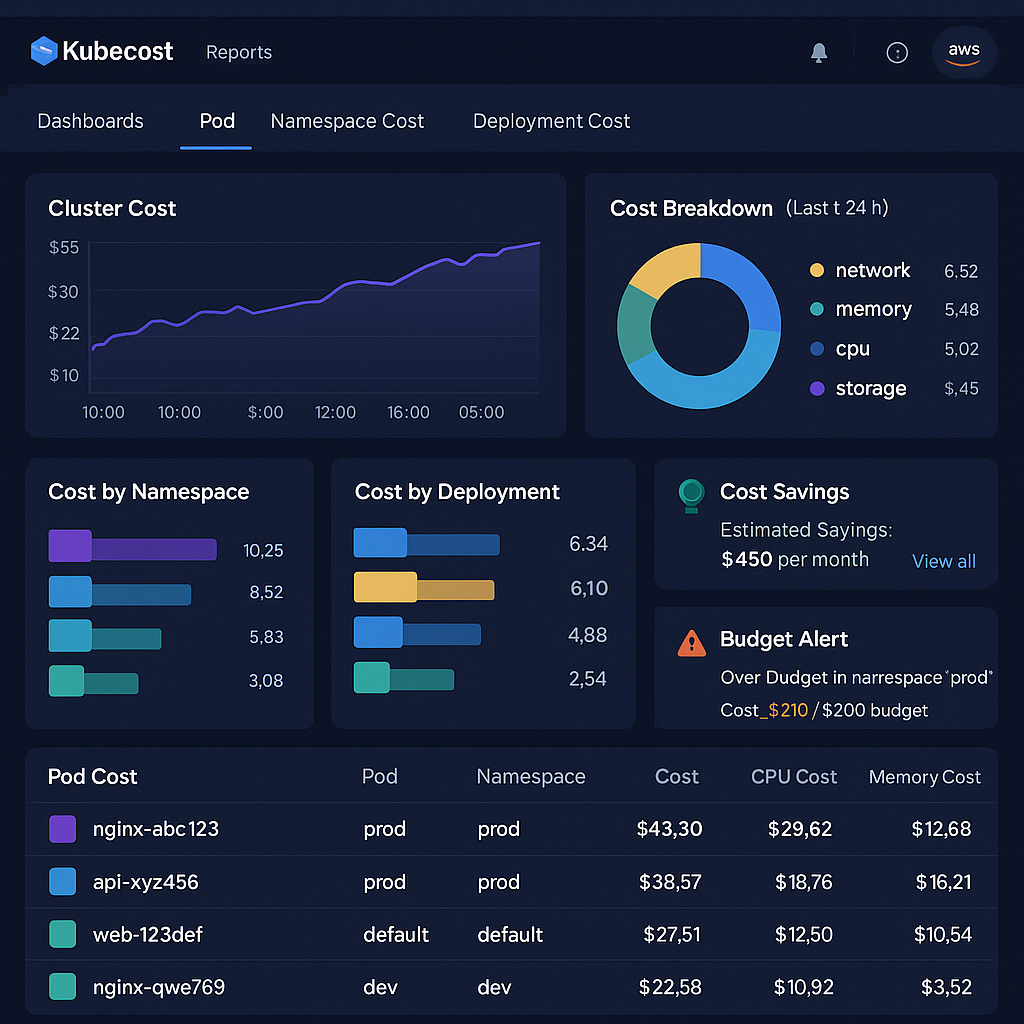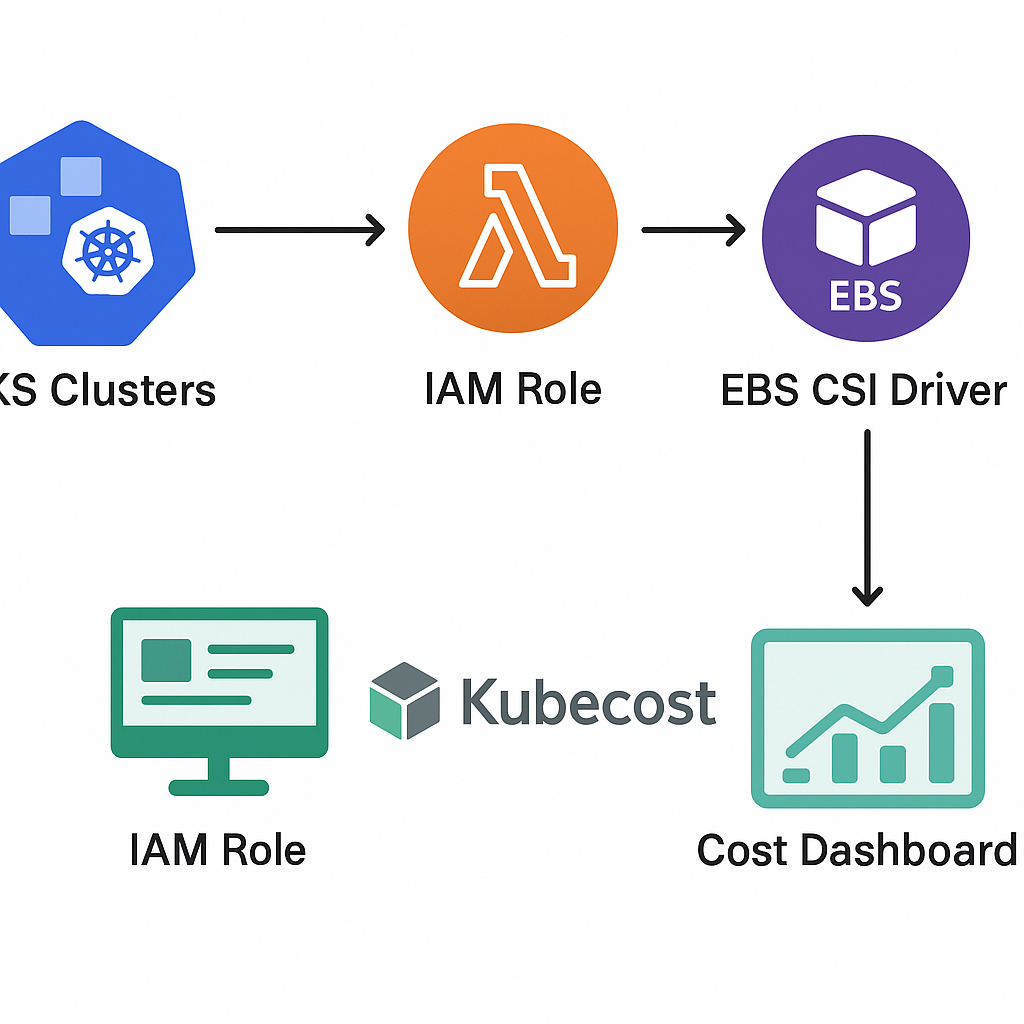Kubecost AWS integration for accurate billing and cost audits
Do you know exactly how much your Kubernetes workloads are costing you on AWS? Most organizations don’t, and this lack of visibility can lead to significant overspending. Integrating Kubecost with your AWS environment, particularly with Amazon EKS, provides the granular cost insights needed to optimize your cloud spending without compromising performance.

What is Kubecost and why integrate it with AWS?
Kubecost is a powerful cost monitoring tool designed specifically for Kubernetes environments. When integrated with AWS services, it provides pod-level cost tracking, allowing you to attribute expenses to specific applications, teams, or projects with unprecedented accuracy.
The integration becomes particularly valuable because AWS’s native billing tools often lack the granularity needed for Kubernetes workloads. By bridging this gap, you can:
- Track costs at the pod, namespace, and deployment level
- Receive real-time cost visibility through intuitive dashboards
- Implement proactive cost management through alerts and recommendations
- Optimize resource allocation based on actual usage patterns
Think of Kubecost as your financial microscope for Kubernetes - where AWS billing gives you the big picture, Kubecost reveals the critical details that often hide significant cost-saving opportunities.
Integration options for AWS EKS
There are two primary methods to integrate Kubecost with your Amazon EKS clusters:
1. AWS EKS Add-on (Recommended)
AWS and Kubecost have collaborated to create an optimized bundle available through the Amazon ECR public gallery. This method offers:
- Simplified installation process
- Pre-configured settings optimized for AWS
- No licensing costs for single-cluster usage
- Support from both AWS (via support contracts) and Kubecost
- High availability through Amazon ECR hosting
This option is ideal for teams wanting a streamlined setup experience with minimal configuration overhead.
2. Helm Deployment
For more customization options, you can deploy Kubecost using Helm:
- Requires Helm 3.9+, kubectl, and optionally eksctl/AWS CLI
- Offers more configuration flexibility
- Suitable for advanced deployment scenarios or unique environments
This approach works best for teams with specific customization needs or existing Helm-based infrastructure management.
Prerequisites for integration
Before installing Kubecost on your EKS cluster, ensure you have:
- An existing Amazon EKS cluster
- The EBS CSI Driver installed (mandatory for clusters version 1.23 or newer)
- Appropriate IAM permissions configured
- Required tools: Helm 3.9+, kubectl, and optionally eksctl and AWS CLI
It’s worth reviewing Kubecost’s architecture overview before deployment to understand how the components will interact with your existing infrastructure.

Step-by-step integration guide
Setting up the EBS CSI Driver
For EKS clusters running version 1.23 or newer, the EBS CSI driver is mandatory, as documented by IBM:
- Create an IAM service account with the required permissions:
eksctl create iamserviceaccount \ --name ebs-csi-controller-sa \ --namespace kube-system \ --cluster YOUR-CLUSTER-NAME \ --attach-policy-arn arn:aws:iam::aws:policy/service-role/AmazonEBSCSIDriverPolicy \ --approve \ --role-name AmazonEKS_EBS_CSI_DriverRole- Install the EBS CSI add-on:
eksctl create addon \ --name aws-ebs-csi-driver \ --cluster YOUR-CLUSTER-NAME \ --service-account-role-arn arn:aws:iam::YOUR-ACCOUNT-ID:role/AmazonEKS_EBS_CSI_DriverRole \ --forceInstalling Kubecost using the AWS-optimized bundle
- Add the Kubecost Helm repository:
helm repo add kubecost https://kubecost.github.io/cost-analyzer/helm repo update- Install the AWS-optimized Kubecost bundle:
helm install kubecost kubecost/cost-analyzer \ --namespace kubecost \ --create-namespace \ --set kubecostToken="REPLACE_WITH_YOUR_TOKEN" \ --set aws.serviceKeyName=REPLACE_WITH_SERVICE_KEY_NAMEAfter installation, you can access the Kubecost dashboard by port-forwarding or setting up proper ingress, depending on your cluster configuration.
Key features and benefits
After successful integration, you’ll gain access to powerful cost management capabilities:
1. Pod-level cost tracking
Kubecost provides granular visibility into your Kubernetes spending by breaking down costs to the pod level. This allows you to precisely allocate expenses to specific applications, services, or teams running on your EKS clusters.
For example, you can immediately identify which microservices are consuming the most resources within a complex application, allowing for targeted optimization efforts rather than blanket cost-cutting measures.
2. Customizable budget alerts
Set up proactive notifications when spending exceeds predefined thresholds. This feature is crucial for maintaining budget discipline and avoiding unexpected cloud bills.
Imagine setting different thresholds for development, staging, and production environments, each tailored to expected usage patterns and budget constraints. When a development environment unexpectedly spikes in cost, you’ll know immediately rather than at month-end.
3. Right-sizing recommendations
Kubecost analyzes your resource utilization patterns and provides actionable recommendations to eliminate overprovisioned resources without impacting performance. According to Hykell, this kind of optimization can help reduce cloud costs by up to 40% automatically.
The system might identify, for instance, that your recommendation service consistently uses only 20% of allocated memory, suggesting a downsizing opportunity that could cut costs without affecting performance.
4. Storage class optimization
Get suggestions to optimize your storage classes, balancing performance requirements with cost-efficiency. Kubecost helps identify when you’re using premium storage for non-critical workloads or when you could benefit from lifecycle policies for infrequently accessed data.
5. Real-time dashboards
Access intuitive dashboards that provide visibility into costs across namespaces, deployments, and pods in real-time. These visualizations make complex cost data digestible for both technical and non-technical stakeholders, facilitating better cross-functional communication about cloud spending.
Best practices for AWS-Kubecost integration
To maximize the value of your Kubecost integration with AWS, follow these best practices:
-
Align teams around cost management using Kubecost’s shared dashboards and alerts to foster a cost-conscious culture. Consider monthly review meetings where engineering and finance teams collaboratively review spending trends.
-
Implement right-sizing recommendations promptly to eliminate overprovisioned resources and reduce waste. Create a regular cadence (weekly or bi-weekly) for reviewing and acting on these suggestions.
-
Optimize storage classes based on workload requirements to balance performance and cost. Consider creating storage class policies that align with data access patterns in your applications.
-
Monitor idle resources regularly to identify and reclaim unused test environments or development resources. Set up automated processes to spin down non-production resources during off-hours.
-
Use the AWS-optimized Kubecost bundle for pre-configured settings that work well with AWS services out of the box, as recommended by AWS.
-
Follow IAM best practices for service accounts to maintain secure access control. Use the principle of least privilege when creating service accounts for Kubecost.
Common challenges and solutions
Challenge: Underutilized resources increasing costs
Solution: Use Kubecost’s utilization metrics to identify idle workloads and implement automated scaling or cleanup processes. Consider implementing autoscaling policies based on actual usage patterns rather than static resource allocations.
Challenge: Multi-cloud complexity
Solution: Leverage Kubecost’s unified cost tracking capabilities if you’re running a hybrid environment that includes AWS alongside other cloud providers. This provides a consistent view across your entire infrastructure, as noted in Hykell’s cloud cost management guide.
Challenge: Cost allocation across teams or projects
Solution: Apply namespace and service-level tagging to accurately attribute expenses to the correct cost centers. Establish a consistent tagging strategy across your organization that reflects your business structure and cost accountability model.
Pricing considerations
-
AWS EKS follows a pay-as-you-go model with no upfront costs, aligning well with Kubecost’s cost-monitoring capabilities. You pay only for the control plane and the underlying compute resources.
-
Kubecost offers a free open-source version for basic usage, while enterprise features may require paid plans. The AWS-optimized bundle is available at no additional cost for single-cluster use.
-
Consider the potential ROI: While there may be some costs associated with Kubecost deployment and maintenance, the cost savings from optimized resource usage typically far outweigh these expenses.
Start optimizing your AWS Kubernetes costs today
Integrating Kubecost with your AWS services, particularly Amazon EKS, provides the visibility and tools needed to optimize your Kubernetes spending without compromising performance. By following the integration steps outlined above and implementing the recommended best practices, you can achieve significant cost savings while maintaining the flexibility and scalability that Kubernetes offers.
Ready to maximize your AWS cost efficiency beyond just Kubernetes? Hykell specializes in automated cloud cost optimization for AWS environments, helping businesses reduce their cloud costs by up to 40% without compromising performance or requiring ongoing engineering effort.
Take control of your cloud spending today and turn cost management from a challenge into a competitive advantage.
